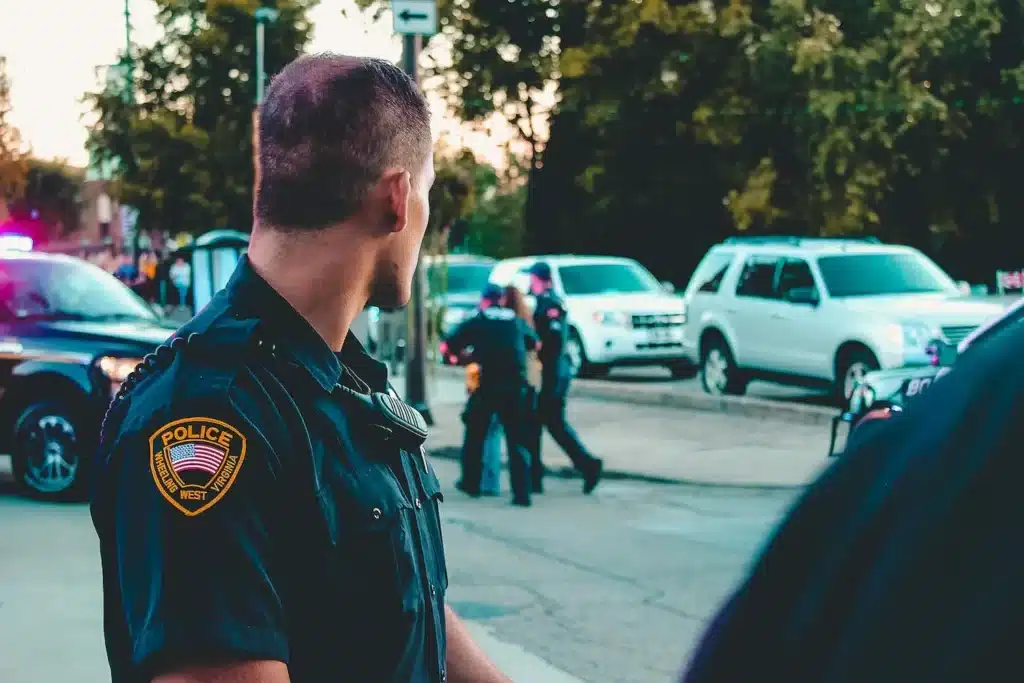The United States federal court process can be long, complex, and confusing. It is definitely intimidating and overwhelming. If you or a loved one have been arrested on federal charges, it is important to understand the federal court process and know what to expect going forward. This general guide aims to simplify the federal court process and offer an overview of the steps involved from arrest to sentencing and appeals.
Arrest
Arrests in federal cases are usually carried out by federal law enforcement agencies such as the Federal Bureau of Investigation (FBI), Drug Enforcement Administration (DEA), Customs and Border Protection (CBP), Homeland Security Investigations (HSI), or the Bureau of Alcohol, Tobacco, Firearms, and Explosives (ATF). There are many different circumstances that may lead to a federal arrest. Sometimes arrests are made as the result of an ongoing or proactive investigation and a warrant has been signed by a federal judge to arrest an individual. Other times, arrests may occur after an individual is suspected of having committed a crime or they are caught in the act of committing a crime, these are reactive investigations. It is imperative to remember that every person arrested in federal court, regardless of their citizenship status, has important constitutional rights such as the right to an attorney, the right to remain silent, and the right to be notified of the charges against them.
Booking
The next step in the federal case process after an arrest is booking. Individuals who are arrested on federal charges will be taken to a federal detention facility or local jail designated for federal detainees. There, they will go through the standard booking process which involves fingerprinting, photographing, and collection of personal information. If someone is arrested on federal charges within the Southern District of California, they will be taken to one of the local federal jails, such as:
- MCC San Diego – Metropolitan Correction Center
808 Union St., San Diego, CA 92101
(619) 232-4311 - Geo San Diego – Western Region Detention Facility
220 West C. St., San Diego, CA 92101
(619) 232-9224 - CoreCivic – Otay Mesa Detention Center
7488 Calzada De La Fuente, San Diego, CA 92158
(619) 671-8799 - Geo El Centro – El Centro Detention Facility
1115 N. Imperial Ave., El Centro, CA 92243
(760) 259-2500 - San Luis Regional Detention Center
406 N. Avenue D, San Luis, AZ 85349
(928) 627-2101 - Santa Ana Jail
62 Civic Center Plaza, Santa Ana CA 92701
(714) 245-8100
If you have a loved one who you believe may have been arrested on federal charges in the Southern District of California and you don’t know where they are, you can contact the United States Marshal Services, San Diego Office at (619) 557-6620.
Initial Appearance
A federal defendant has a right to an initial appearance within 48 hours of their arrest. Prior to the initial appearance, a defendant will have the opportunity to meet with counsel and provide background information for possible pretrial release. During the initial appearance, a judge will inform the defendant of the charges against them, their constitutional rights, and next court dates. The judge will also determine if a defendant is eligible for court appointed counsel.
Detention Hearing
Either at the initial appearance or shortly after, a detention hearing may be held to determine if the defendant should be released from custody on bond pending trial. A defendant has the option to stipulate to detention without prejudice (meaning they can come back and ask for bond at a later date), continue their detention hearing to another day, or proceed with their detention hearing. If the detention hearing goes forward, the judge will hear arguments from defense counsel, the government, and pretrial services regarding why the defendant should or should not be released on bond. Factors a judge may consider in whether or not to grant pretrial release include seriousness of the charges, ties to the local community, criminal history, danger to the community, and risk of flight. If bond is granted at the detention hearing, the defense will need to file a bond packet with the court before the defendant is released from custody.
Indictment
The next step is the indictment process before a grand jury. During this proceeding a grand jury reviews evidence presented by federal prosecutors and determines if they believe there is probable cause to hold the defendant on the charges. Defense counsel is never present during these secret proceedings, although the defendant will have the opportunity to consult with their attorney before, during, and after the grand jury proceedings. If the grand jury determines there to be probable cause they will issue an indictment formally charging the defendant. A defendant also has the option to waive their right to be indicted by a grand jury and move forward with their case by way of another formal charging document called an information. Waiving indictment is almost always without prejudice to the defendant.
Arraignment
After an information is filed or a defendant is indicted by a grand jury, the defendant will appear in court to be arraigned on the charges by a federal judge. During this proceeding, a defendant will again be informed of the charges against them, enter a plea of not guilty, be informed of future court dates, and learn who their trial and sentencing judge will be.
Pretrial Phase
Once a defendant is arraigned, their case moves into the pretrial phase. During this phase, the prosecution will provide “discovery” or evidence to the defense which can take several months to process and review, depending on the complexity of the case. Defense counsel may also retain their own investigators to gather evidence for trial and work to disprove the government’s allegations. Motions may be filed during this pretrial phase and additional discovery requests may be made if defense counsel believes there is outstanding evidence yet to be provided by the government. A defendant will also have the opportunity to appear in court for a motion hearing and argue to the judge why their motions should be granted.
This is the phase in the federal case process where most cases come to an end because some sort of plea agreement is reached, and the defendant appears in court to plead guilty before a federal judge. If the defendant pleads guilty, the case will proceed to sentencing and there will be no trial.
Motions in Limine Hearing
If the case proceeds to trial, however, both the defense and government will have the opportunity to file motions in limine. These are pretrial motions that seek to exclude specific evidence or arguments from being presented in front of a jury at trial. These motions are decided by a judge outside of the presence of the jury.
Trial
Federal trials vary in length depending on the amount of evidence, number of witnesses, and overall complexity of the case. The first stage of trial is called voir dire. This is the process where potential jurors are questioned by the judge, prosecutor, and defense counsel. A federal criminal jury generally consists of 12 people and 2 alternate jurors.
After a jury is selected, both sides will give their opening statements and then the government will present their case to the jury. The prosecutor will introduce evidence and likely call witnesses to testify against the defendant on direct examination. The defense will also have the opportunity to question each of the government’s witnesses on cross examination. The government presents their case first because they have the burden of proof to prove to the jury beyond a reasonable doubt that the defendant is guilty of the charges. After the government rests, the defense will have their opportunity to present their case, introduce their own evidence, and call their own witnesses for direct examination. Like the defense, the prosecutors will also have the opportunity to question the defense witnesses on cross examination.
Once both sides have presented their case, the trial will move on with closing arguments from the prosecution and defense. Finally, the judge will read the jury specific jury instructions detailing their role in jury deliberation and exactly what the government is required to prove to them to find the defendant guilty beyond a reasonable doubt.
The jury then moves forward with private jury deliberation until a verdict is reached or no decision can be made. A “hung jury” occurs when the jury cannot agree on a final verdict. If even one juror disagrees with the rest and cannot decide the jury will be considered hung. In that event, the government has the option to retry the case on the same charges, offer new charges for possible settlement, or reject moving forward with the charges and any trial and instead dismiss.
If a verdict is reached, however, the defendant will be called back into court and a judge will read the final decision of guilty or not guilty. Some federal judges require that defendants go immediately into custody after a guilty verdict is read. Other judges may allow a defendant to remain out of custody for a short period of time so they can prepare for sentencing, assuming they have been compliant while on bond.
Sentencing
A federal case proceeds to the sentencing phase when the defendant has pleaded guilty or is found guilty after trial. The government, defense, and U.S. Probation Department will each have an opportunity to submit sentencing papers and sentencing recommendations prior to the sentencing hearing for the judge to review and consider. The parties will also have the opportunity to argue on the record at sentencing and the defendant is allowed to make a final statement to the judge called an allocution. The judge will consider any plea agreement that has been reached between the parties that may specify a recommended sentence. The judge will further consider the charges to which the defendant has pleaded guilty, the defendant’s criminal history, the victim and community impact, the need for general and specific deterrence, any mitigation that’s presented, the defendant’s release plans, and other factors presented at sentencing before making the final ruling.
Appeals
If the defendant was convicted at trial, they have the right to appeal their verdict or sentence to a higher court. If they pleaded guilty, however, part of the plea agreement will often require them to waive their right to an appeal unless it is for ineffective assistance of counsel. The appeals process involves submitting briefs and may include oral arguments before a panel of appellate judges. The appellate court may affirm the conviction, overturn the conviction, or order a new trial or resentencing if errors are found to have affected the defendant’s rights or final verdict at trial.
Experienced Federal Criminal Defense Attorneys
Navigating the federal criminal justice system is complicated. It is crucial for defendants and their loved ones to understand their rights, the federal court process, and what to expect when someone is arrested on federal charges. At the Law Offices of David Silldorf, we work to ensure our clients and their families are better equipped to face the challenges ahead and know what to expect in the federal case process every step of the way.





